
Which Vacuum-Insulated Solution Is Right for You?
Let’s keep this simple and practical. Below is a big-picture tour of our vacuum-insulation family—each product engineered to cut heating and cooling losses while fitting real-world budgets, schedules and constraints. I’ll show where each one works best, then give you a quick selection guide you can use today.
Start with your scenario
Pick the situation that sounds most like yours.
- “I need the thinnest, highest insulation—custom shapes, tight spaces.”
Choose Flexible VIPs. Ultra-low thermal conductivity (λ ≈ 0.0025 W·m⁻¹·K⁻¹ in our programme), shaped and notched to fit façades, reveals, EV battery packs, HVAC ducts, cabinet doors and data-centre racks. - “I’m upgrading the façade and need A1 non-combustible performance with a premium finish.”
Choose DVIP. A 30 mm decorative cladding panel with A1 fire-rated configurations that can outperform much thicker mineral wool systems, while delivering architectural colours and textures. - “I want a rapid DIY fix for cold or hot walls—no builders.”
Choose VIW. 4 mm peel-and-stick vacuum-insulated sheets. In typical single-brick examples, VIW cuts effective heat flow dramatically (up to ≈87% in worked comparisons), with clean decorative finishes. - “I move temperature-sensitive goods and want long hold times without power or ice.”
Choose VIBB. Our Vacuum-Insulated Bag-or-Box range—Medical Box, Deep Cold Box, Rolling Cart Cover, and Fresh Bag—keeps 2–8 °C for hours to days (scenario-dependent) without plugs or gel packs. - “Windows are the weak point; I can’t replace glazing (listed building, rental).”
Choose VIC. A vacuum-insulated curtain with U = 1.87 W·m⁻²·K⁻¹ that installs like any drape and can trim window losses by about 33% in use—no contractors, no scaffolding. - “I want the benefits of VIC plus gentle heat for evening comfort.”
Choose VIHC. Our heatable variant combines a 3 mm vacuum layer with an ultra-thin heating mesh; around 1 kWh for three hours of soft radiant warmth. TRL 9 and launching 2025.
New application ideas you may not have considered
Buildings and estates
- Heritage façades: DVIP to upgrade thermal performance while preserving streetscape; VIC or VIHC internally for listed windows where replacement is prohibited.
- Social housing portfolios: VIW in cold rooms and reveals; VIC for night-time heat retention; standardised VIP cassettes for communal areas.
- Student halls & HMOs: VIW for quick wins during summer breaks; VIC to stabilise night-time comfort with minimal maintenance.
- Hotels: VIC or VIHC on street-facing glazing to cut boiler runtime; VIBB Rolling Cart Covers to keep banqueting food in range from kitchen to ballroom.
- Healthcare and labs: DVIP façades for non-combustible performance; VIBB Medical Boxes for vaccines and pathology routes; VIC to reduce draughts in wards without touching the windows.
- Museums & archives: VIC to stabilise display-case rooms; VIP liners in climate enclosures; DVIP for back-of-house walls where fire class is critical.
- Schools & nurseries: VIHC for zoned warmth in early-morning occupancy; VIW for north-facing classrooms.
Transport, mobility and industrial
- EV and battery systems: Flexible VIPs for pack separators, cabin hot-spot shielding and HVAC ducts; VIBB for temperature-controlled spares and chemistry samples.
- Rail, metro and coach interiors: VIPs in door panels and bulkheads to reduce HVAC load without stealing passenger space.
- Cold-store docks and last-mile delivery: VIBB Rolling Cart Covers to avoid temperature excursions during loading and staging.
- Caravans, motorhomes and marine: VIPs in fridge liners and hatch insulation; VIC for panoramic glazing when parked.
- Data centres & edge sites: VIPs for hot-aisle containment skins, battery rooms and door panels; VIHC for staff comfort during maintenance windows without touching facility HVAC.
- Construction site welfare cabins & modular units: VIW for rapid setup; VIC to temper large glazed fronts.
Public service and humanitarian
- Vaccination outreach & field clinics: VIBB Medical Boxes for 2–8 °C transport and staging; VIW to improve thermal comfort in temporary rooms.
- Disaster relief: VIBB for medicines and safe food distribution; VIW and VIC for rapid shelter upgrades where power is scarce.
Retail and food service
- Fresh-food e-commerce: VIBB Deep Cold Boxes for routing to micro-fulfilment hubs; Rolling Cart Covers for in-store picking runs.
- Cafés and hospitality: VIHC in seating zones near glass to lift perceived comfort without turning up the thermostat.
Product snapshots—what you should know before you specify
1) Flexible Vacuum Insulation Panels (VIPs)
- Why: Maximum R-value at minimal thickness; custom geometries.
- Where: Façades, reveals, HVAC, doors, vehicles, EVs, data-centre racks.
- Headline: λ ≈ 0.0025 W·m⁻¹·K⁻¹ in our programme; complex shapes and cut-outs available.
- Note: Protect against puncture; design fixings and edges early.
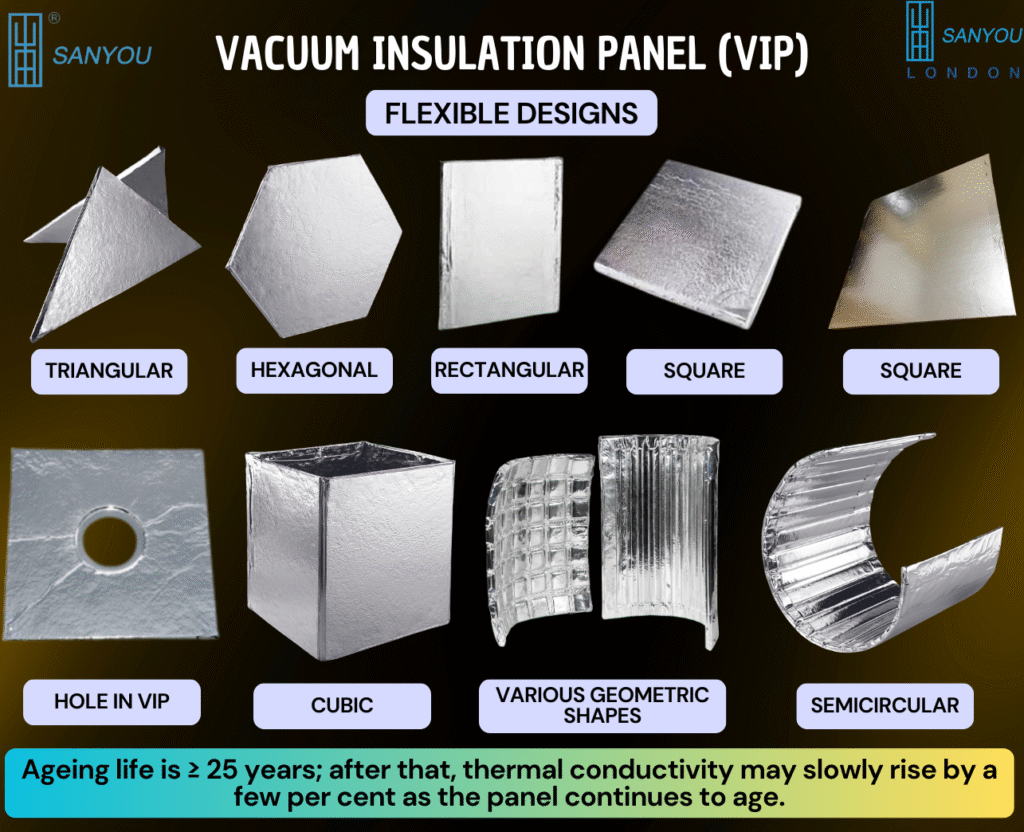
2) Decorative Integrated VIP (DVIP)
- Why: External wall upgrade with A1 fire-rated options and a designer finish.
- Where: New-build and retrofit façades; exposed walls needing weatherable skins.
- Headline: ≈30 mm panel; lab data show conductivity < 7 mW·m⁻¹·K⁻¹; outperforms very thick conventional build-ups at like-for-like thickness.
- Note: Factory-assembled panels improve programme certainty; full CAD support.
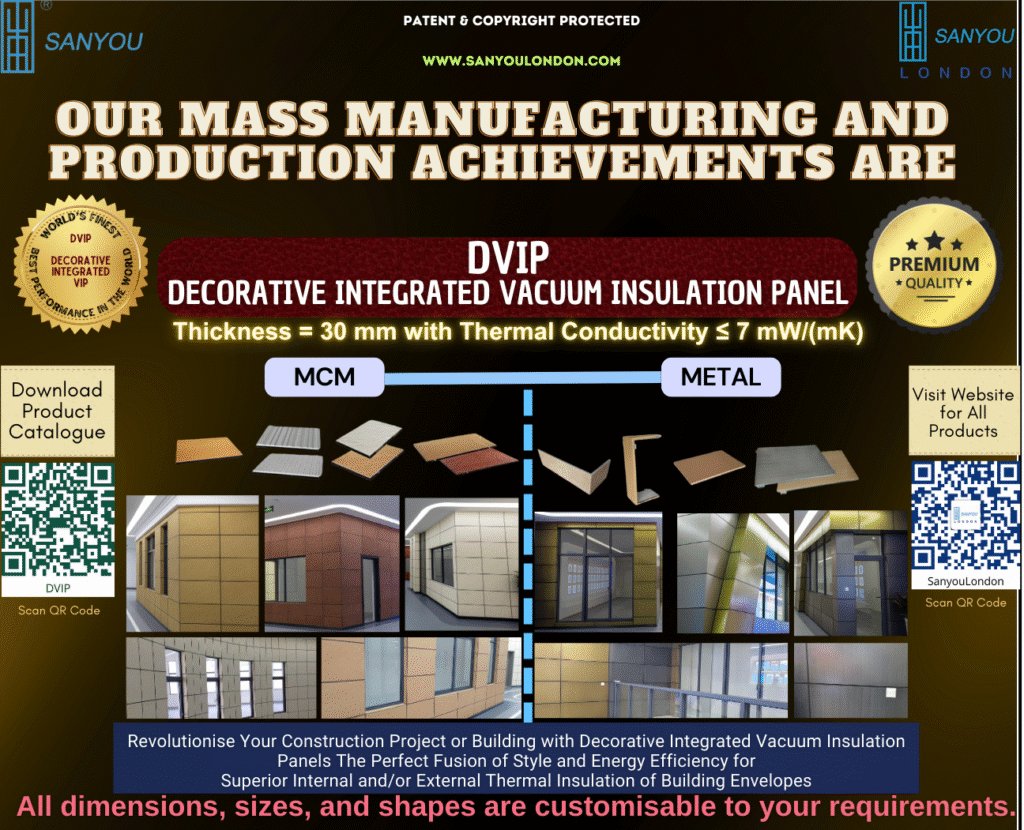
3) Vacuum Insulated Wallpaper (VIW)
- Why: DIY, fast, thin and decorative; apply to the rooms you feel most.
- Where: Cold north-facing walls, box rooms, flats where external EWI is impossible.
- Headline: ≈4 mm; λ < 5 mW·m⁻¹·K⁻¹; up to ≈87% heat-flow reduction in worked wall examples; typical UK payback measured in a few years per m².
- Note: Prepare dry substrates; avoid penetrations; stagger sheets for a neat finish.
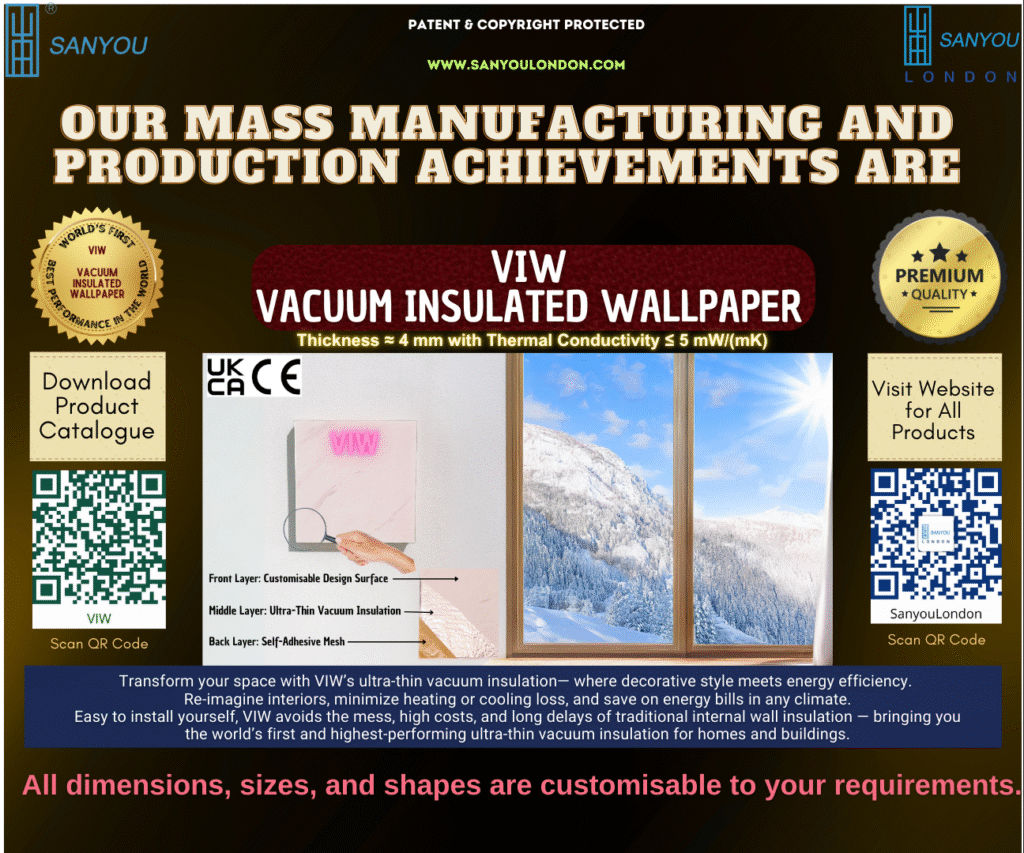
4) VIBB—Vacuum-Insulated Bag-or-Box
- Why: Hold temperature without power or ice; simpler SOPs, less waste.
- Where: Healthcare, food service, agriculture, emergency response.
- Headline: Medical Box maintains 2–8 °C for days in moderate ambients; Deep Cold Box for multi-day food logistics; Rolling Cart Cover holds <10 °C over service windows; Fresh Bag keeps groceries safe on hot days.
- Note: Pre-condition loads; pack densely; limit openings to extend hold time.
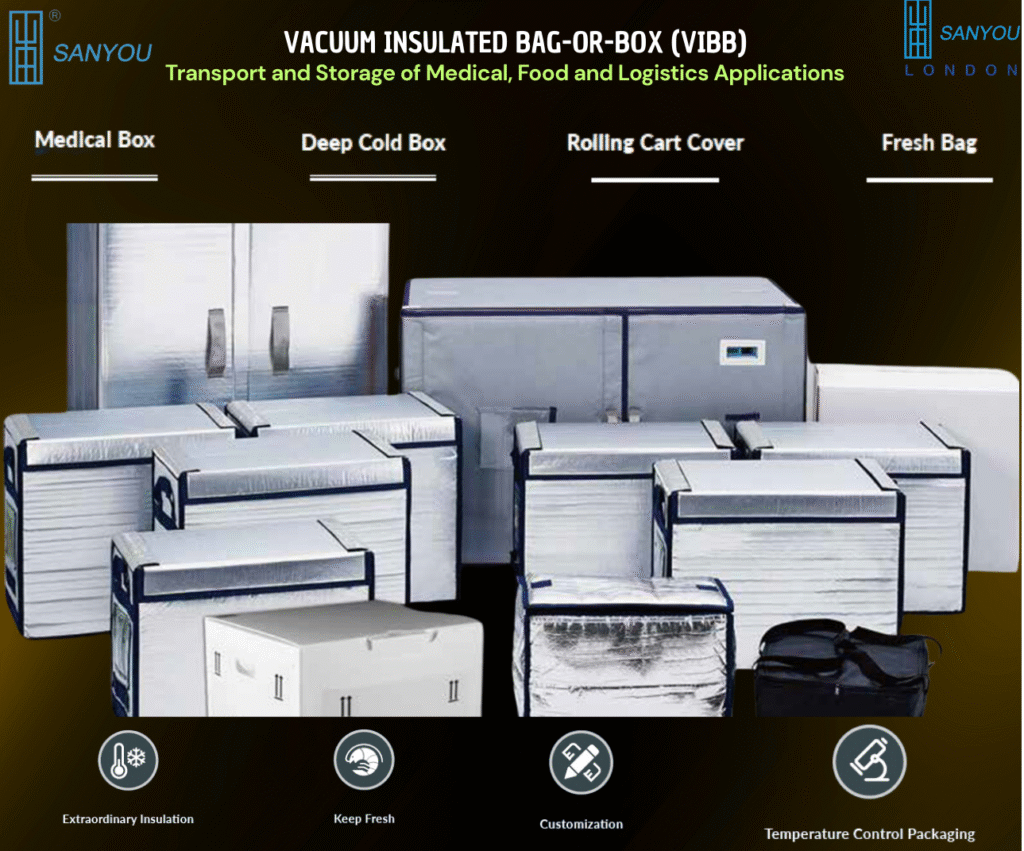
5) Vacuum Insulated Curtain (VIC)
- Why: Window losses without window works; ideal for rentals and heritage.
- Where: Homes, hotels, offices, schools—anywhere glazing dominates comfort.
- Headline: U = 1.87 W·m⁻²·K⁻¹ curtain assembly; about 33% window-loss reduction in use; installs like any drape; VIP tiles are removable.
- Note: Add side returns and sensible stack-back to minimise edge effects.
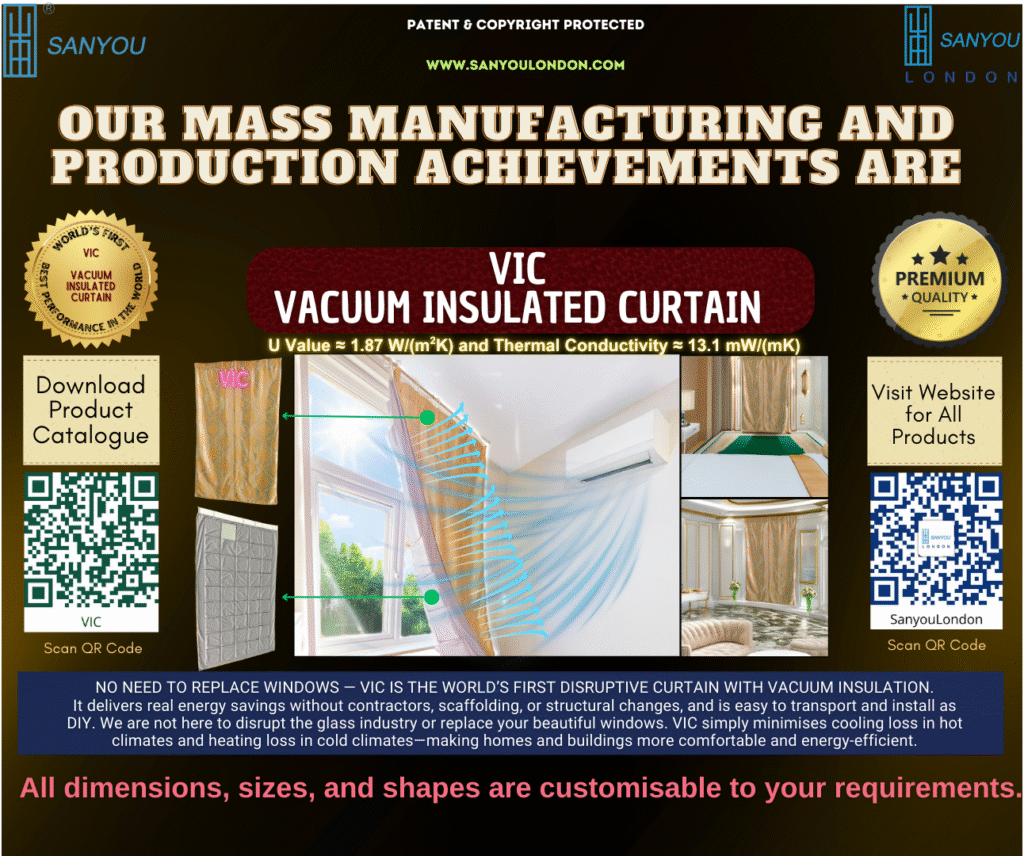
6) Vacuum Insulated Heatable Curtain (VIHC) — launching 2025
- Why: Insulate and add gentle radiant warmth at low power.
- Where: UK/EU living rooms, bedrooms, study spaces; hotels and lounges.
- Headline: 7 mm assembly; vacuum layer plus ultra-thin heating mesh; ≈1 kWh for 3 h of comfort; TRL 9.
- Note: Plug-in convenience; plan a tidy cable route; integrated safety controls.
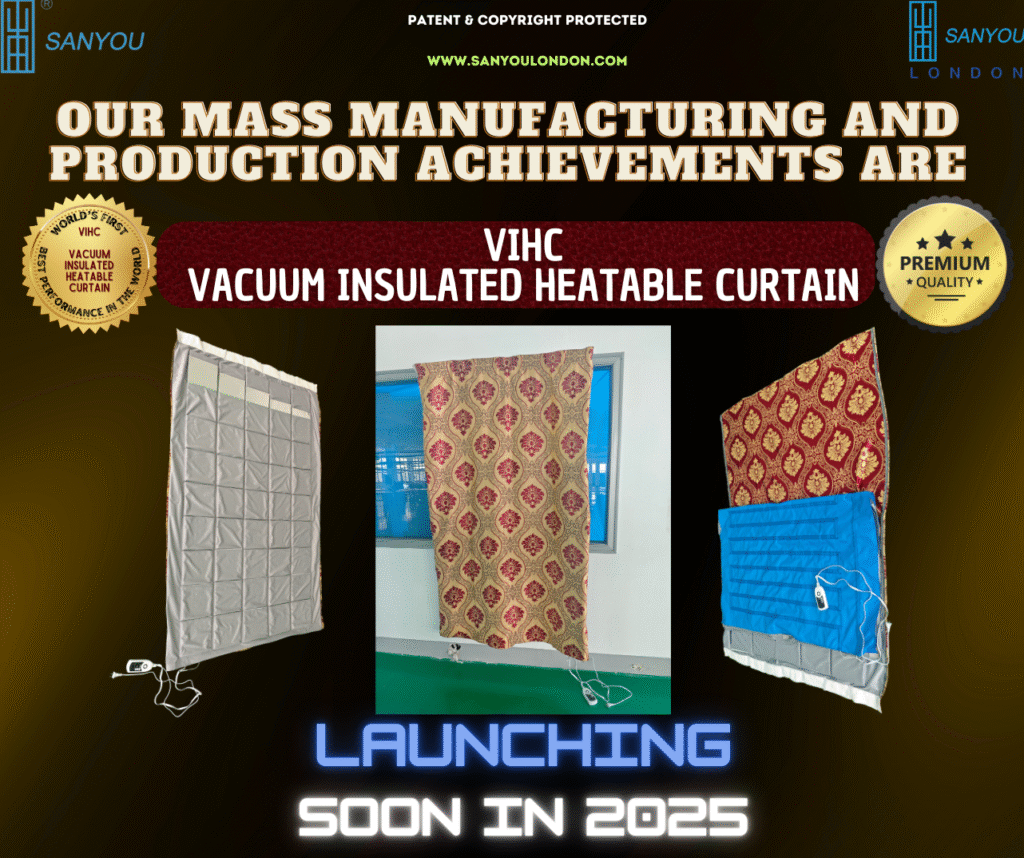
How to choose—three quick questions
- Is the problem the wall, the window, or the route?
Wall → VIW or VIP/DVIP. Window → VIC/VIHC. Transport/storage → VIBB. - Do you need non-combustible façades with a finished look?
Yes → DVIP. No → VIP cassettes or VIW for interiors. - DIY or contractor install?
DIY → VIW, VIC, VIHC, VIBB. Contractor/architect-led → VIP, DVIP.
Budget and payback—rules of thumb
- DIY upgrades (VIW, VIC, VIHC): lowest disruption, fastest path to comfort; paybacks typically in a few winters depending on tariff and room usage.
- Façade projects (DVIP): capex is higher but combines energy, aesthetics and fire performance in one scope; value uplift through improved EPC and curb appeal.
- Industrial and logistics (VIP, VIBB): savings arise from smaller HVAC loads, reduced spoilage, and simplified operations; often compelling on operational cost alone.
We can run a free, quick-turn payback sketch if you share your tariffs, hours of use, wall or window areas, and a photo or drawing.
Engineering notes
- All performance figures are from our development and test programme or worked design examples. Real outcomes vary with geometry, fixings, air-tightness, solar gains, usage patterns and local climate. We’ll help you specify to the result you want.
- For safety, durability and compliance, ask us for CAD details, installation sheets and fire classifications matched to your project.
Ready to move from idea to action?
- Contact our Customer Service Team for samples, specifications, CAD support and tailored pricing.
- Prefer a direct conversation? Email or phone Professor Saim Memon—let’s review drawings, run a quick U-value or route-hold estimate, and map the fastest path to impact.
- Download all catalogues, purchasing steps, videos and FAQs at www.sanyoulondon.com.
DIY-friendly, heritage-safe and net-zero oriented—backed by 15 years of peer-reviewed research and global collaboration.
We ship worldwide: UK, EU, USA, Canada, Australia, Middle East and beyond.
Share

Author
Prof. Dr. Saim Memon
PhD, CEng, FHEA, MSc, BEng(Hons), PGC-TQFE, GTCS, MCMI, MIET, MIEEE, MInstP, IBPSA, APCBEES, MPEC
CEO | Industrial Professor | Inventor | British Scientist | Chartered Engineer | Qualified Teacher | Chief Editor | World Speaker | Pioneer in Vacuum Insulation Energy Technologies

